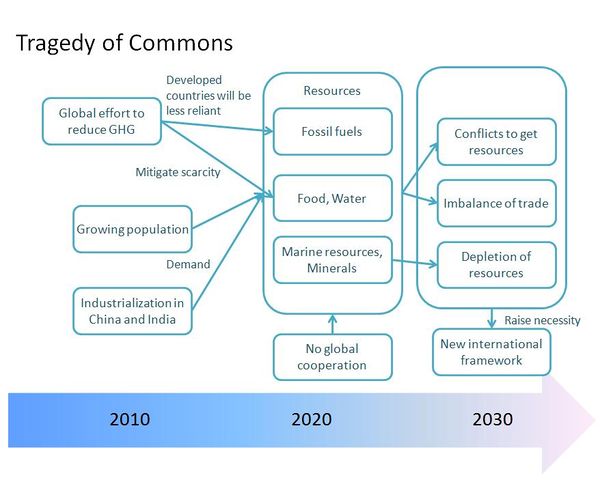Tragedy of Commons
Summary
Global cooperation on green house gas emissions are established avoiding rising temperatures. However, growing population and industrialization made resource issues more serious. China and India have become economic powerhouses with huge demands on resources. Varying resources and national interests causes global leaders to struggle with making international regulations in order to consume resources sustainably. By the 2020s, some natural resources started to deplete, and countries stockpiled their resources locally. Increases in resource prices affected all product prices, and least developing countries could not follow this movement. Thus, countries reserving natural resources have prospered on one hand, and the gap between rich and poor countries has widened on the other hand. The inability of nations to negotiate on sustainability issues beyond climate change creates friction and leads some nations to war.
Description
2010
World leaders including China, Russia, and India started working on reducing greenhouse gas emissions in order to mitigate climate change in 2010. The Copenhagen Protocol of December 2009 and following meetings were successful in deciding new targets of green house gas reduction and methods to achieve this target. Adoption of reduction rules was universal by 2013. These rules imposed limits of green house gas emissions throughout the manufacturing processes on companies and financial incentives were adopted to popularize green technologies such as electric vehicles and renewable energies. Although people still made purchase decisions based on the price of products, they increased the consumption of eco-friendly products because local regulations barred cheap eco-unfriendly products from markets while financial incentives compensated the price gap. According to the Intergovernmental Panel on Climate Change, it was expected in 2010 that the temperature would increase by approximately 0.2 degree Celsius for every decades by 2030. Global cooperation succeeded in getting the earth on the track of the normal climate cycle. However, people’s active consumption brought up another problem, scarcity of resources. China continued securing resources in the developing nations such as Nigeria. By consulting on infrastructure projects, China created deals to become a leading customer to the natural resources of the nation. Stakeholders in these deals begin to question China as they were deemed as the only beneficiary.
2020
China and India become one of the wealthier countries in the world and industrialization in these countries accelerated global consumption of resources. Reserves of nonrenewable resources such as oil and metals declined rapidly and consumption of renewable resources exceeded the speed of replacement. Depletion of resources became a more serious problem than before, and their price soared. Although prevention of global warming and technological development contributed to increased supply of resources, demand increased further. Countries which had natural resources came to have stronger political power. As developed nations and these countries with natural resources vie for power conflicts arise. Nigeria is able to leverage its deals with China to build its infrastructure and become less dependent on China. China protests Nigeria’s independence and demands compensation for efforts and services delivered. These disagreements lead to incidents of attacks on Chinese individuals working in Nigeria. Developed countries, which relied on import of resources, enhanced the recycling of metals and utilization of bio-fuels. High material prices continued to undermine developed nations industries. Increasing price of commodities fatally hit the economy in the least developed countries which could not secure natural resources domestically.
2030
The world population reached 7.9 billion, 117% compared with the level in 2010. Consumption and industrialization levels do not alter. Environmental sustainability is accepted by all countries. However, sustainability is not addressed quickly for all issues. Taking the example of tuna fishing in the Mediterranean, some countries, which were making a business out of fishery, disagreed with volume control. Interests were different for each country and resource, and regulations had to take into account this issue. Negotiations gradually showed positive results, but the delay of the decision made the problem worse. Some resources had almost depleted when new regulations were finally adopted. Wars erupt as resources are fought over. China’s imposes trade embargoes on resource rich nations unwillingly to cooperate. Terrorist acts against Chinese assets occur to disrupt the shipment of resources back to China.
Developed nations in Northern Europe are able to establish sustainable economies that are less reliant on dwindling resources. Oil imports are minimized as solar, wind and geothermal energies are fully implemented. The United States economy struggles as it is unable to shift away from importing key resources as easily as Northern European countries. The world becomes dividing into three poles – developed nations that are sustainable, developed nations fighting for resources, and developing nations suffering from lack of resources and industrialization.
Common characteristics
People’s lifestyles and consumption habits change slightly. People accept green house gas emission regulations and environmentally friendly products. However, issues of sustainability do not stop at environmental issues. Although nations agree to cooperate on environmental issues, other issues of trade and resources still have a national focus. Industrialization and consumption of resources continue at exponential rates. Due to the global cooperation, we avoided 2 degrees Celsius of global warming which was expected in 2010. This stopped desertification and deforestation as well. However, growing population and industrialization accelerated global consumption of resources. Several natural resources become depleted.
Key Uncertainty
A key uncertainty is the level of cooperation governments will have. Traditionally countries seek self interest and national goals. If nations can see the benefit of working together then the ability to establish international frameworks on sustainability are possible.
